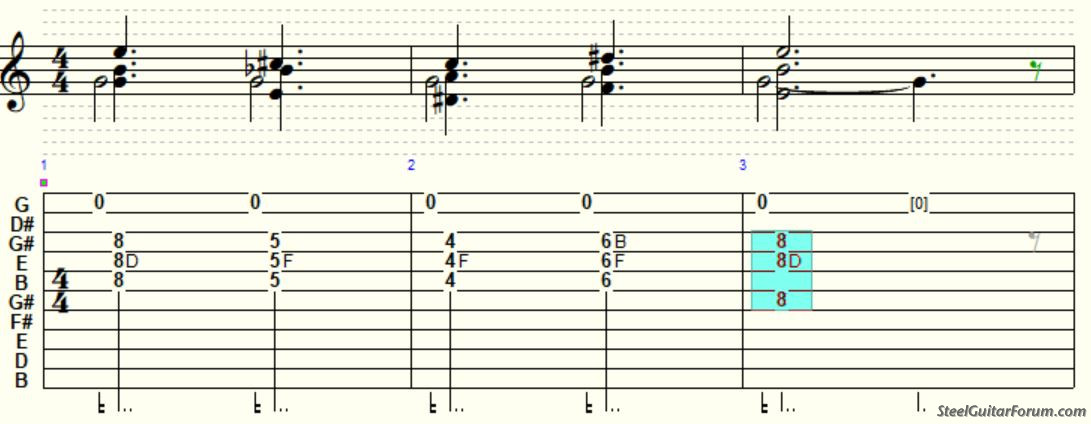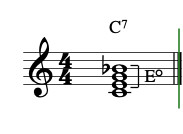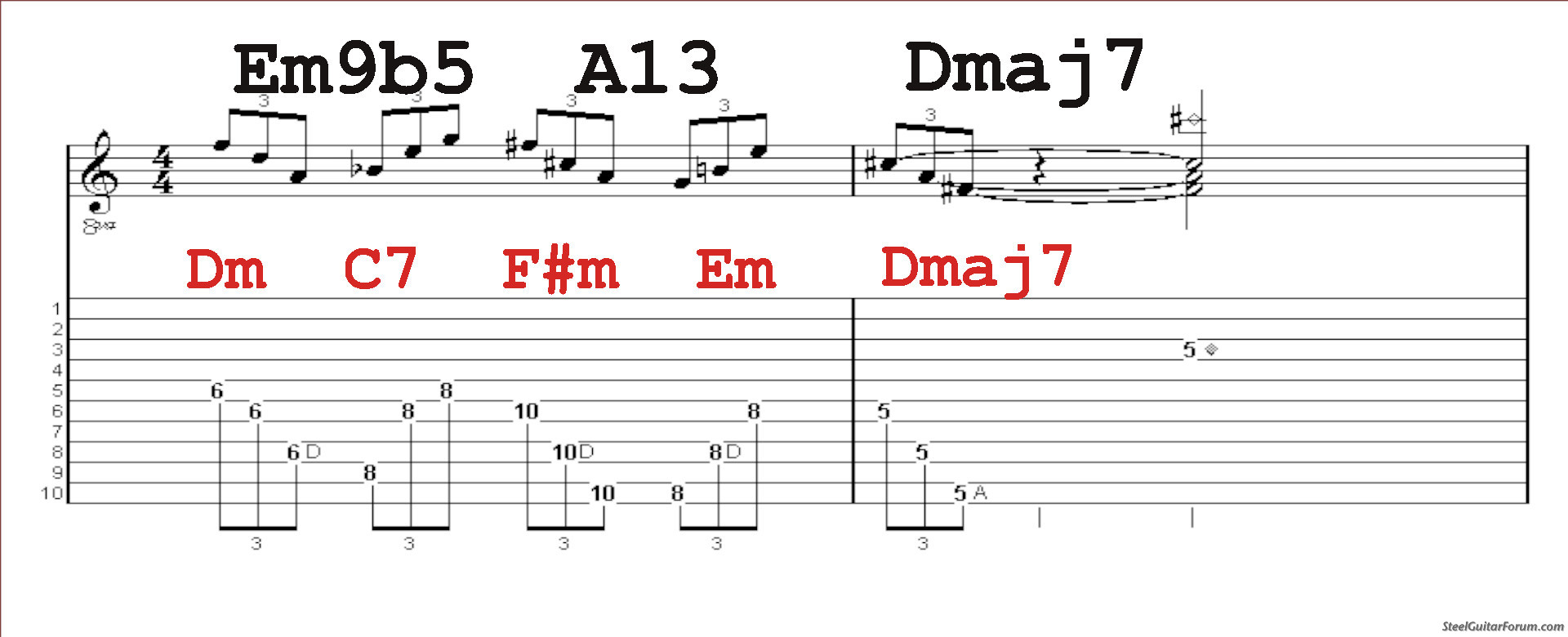What about kickin' some E9 Triads around?
Moderator: Shoshanah Marohn
What about kickin' some E9 Triads around?
Well we’ve heard here a lot about how important learning to hear the intervals and of course one of the first thrills we got while learning steel is when we slammed that lever that flattens the Es with the B pedal down making a 7th chord and pee run down our leg. (I stole that pee thing from Joe Wright)
What I don’t hear a lot about is Triads.
A long with those intervals and those thrilling 7th chords, triads are the basic building blocks of harmony and melody.
You would think a deep comprehension of Triads would be an absolute must for anyone playing E9 PSG since most play with thumb and two fingers and the E9 is not tuned for those C6 big fat anal chords.
What I don’t hear a lot about is Triads.
A long with those intervals and those thrilling 7th chords, triads are the basic building blocks of harmony and melody.
You would think a deep comprehension of Triads would be an absolute must for anyone playing E9 PSG since most play with thumb and two fingers and the E9 is not tuned for those C6 big fat anal chords.
- Guy Cundell
- Posts: 901
- Joined: 31 Jul 2008 7:12 am
- Location: More idle ramblings from South Australia
- Contact:
- Dennis Detweiler
- Posts: 3488
- Joined: 8 Dec 1998 1:01 am
- Location: Solon, Iowa, US
Lloyd Green instrumental called, "Triad"
1976 Birdseye U-12 MSA with Telonics 427 pickup, 1975 Birdseye U-12 MSA with Telonics X-12 pickup, Boss 59 Fender pedal for preamp, NDR-5 Atlantic Delay & Reverb, two Quilter 201 amps, 2- 12" Eminence EPS-12C speakers, ShoBud Pedal, 1949 Epiphone D-8. Revelation preamp into a Crown XLS 1002 power amp.
- Guy Cundell
- Posts: 901
- Joined: 31 Jul 2008 7:12 am
- Location: More idle ramblings from South Australia
- Contact:
-
Darrell Criswell
- Posts: 874
- Joined: 28 Nov 2006 1:01 am
- Location: Maryland, USA
-
Pete Finney
- Posts: 1617
- Joined: 6 Sep 1998 12:01 am
- Location: Nashville Tn.
I think what Jeff likely would have meant by "more musical" (in the context of sharing his knowledge of classic E9 country steel playing), is that two-note (dyad) harmonies of 3rds and 6ths often lay better in a track and sound cleaner than full triads. Assuming a typical commercial track with keyboards and multiple guitars, you're likely doubling some notes that are already there in the same frequency range and not only will the track feel more cluttered with full three note chords but you're also more likely to find minor clashes of intonation.Darrell Criswell wrote:What does "musical" mean?Ian Rae wrote: Jeff Newman discouraged triads because thirds and sixths sound more musical.
That's what I got from him back in the day anyway. And an awful lot of the classic Emmons, Green, Rugg and Myrick etc. playing of the day behind singers leans heavily on two-note harmonies for probably just those reasons. And because the producers that hired them probably agreed!
- Fred Treece
- Posts: 3920
- Joined: 29 Dec 2015 3:15 pm
- Location: California, USA
Re: What about kickin' some E9 Triads around?
It’s an excellent point. There are a few full 5-note altered chord possibilities on E9, but breaking up many others into separate triads at different frets is oftentimes a more convenient option. Playing them one or two notes at a time is in keeping with the Newman concept, but I’ve recently heard that occasionally breaking the rules can be a refreshing course of action...Bo Legg wrote:Along with those intervals and those thrilling 7th chords, triads are the basic building blocks of harmony and melody.
You would think a deep comprehension of Triads would be an absolute must for anyone playing E9 PSG since most play with thumb and two fingers and the E9 is not tuned for those C6 big fat anal chords.
Those Dm/C7 triad substitutes for Em9b5 are not doin it for me though. Gm/D+ maybe? I mean, its already a pretty weird chord.
- Andrew Frost
- Posts: 497
- Joined: 12 Feb 2014 9:46 am
- Location: Toronto, Ontario
The example was thrown together to show one of the directions I was going with this.
I'm sure there are a lot better choices.
Another direction is to:
On the E9 use the triads of a major, minor, dom7 with no root, and augmented.
Use these to cover all the chords.
Example:
A7 no root =
A7, Bb(dim), C#m(b5), Eb(7b9), C(b9), Bm(6b5) and Em(6).
tune a drone note on the 1st or 2nd string.
example: I tuned the 1st string up to a G and droned it through all three Bars
Click here for clip
the progression is
..............Cmaj7..........Eb(7b9).......... Abmaj7(b9).... Db(9b5).......... Cmaj7
................Em................F#7.......... .......F7............. Gaug7.............. Em

I'm sure there are a lot better choices.
Another direction is to:
On the E9 use the triads of a major, minor, dom7 with no root, and augmented.
Use these to cover all the chords.
Example:
A7 no root =
A7, Bb(dim), C#m(b5), Eb(7b9), C(b9), Bm(6b5) and Em(6).
tune a drone note on the 1st or 2nd string.
example: I tuned the 1st string up to a G and droned it through all three Bars
Click here for clip
the progression is
..............Cmaj7..........Eb(7b9).......... Abmaj7(b9).... Db(9b5).......... Cmaj7
................Em................F#7.......... .......F7............. Gaug7.............. Em

Hey Guy jump in on cademtial theory.Guy Cundell wrote:To keep your example consistent you would probably want to relabel the C7 as Edim and maybe the cadential chord as F#m also.
I wanted to get a little further into this before Stuart
jumped in on Cardential theory. He was all over me right after your thread.
However if you read my comments above it will explain why I use the label C7. I did mislabel Dmaj7 should been F#m.
I should have taken more time with all aspects in this endeavor. I really never expected anyone to pay that much attention
- Fred Treece
- Posts: 3920
- Joined: 29 Dec 2015 3:15 pm
- Location: California, USA
I don’t see how A7 no root is equivalent to Bm6b5.A7 no root =
A7, Bb(dim), C#m(b5), Eb(7b9), C(b9), Bm(6b5) and Em(6).
Bbm6b5, yes, but that’s already covered in the Bbdim.
That second line is a pretty sweet sounding sequence, however you want to label the chords. An interesting application of triads.
Aren’t triads always 1-3-5, with an occasional sharp 5 here and a flat 3 there?
Last edited by Fred Treece on 19 Jun 2021 7:58 pm, edited 1 time in total.
- Guy Cundell
- Posts: 901
- Joined: 31 Jul 2008 7:12 am
- Location: More idle ramblings from South Australia
- Contact:
Bo, the triad in your first example is an Edim triad in 2nd inversion which fits your discussion. Cadential just means final or resting point.
The whole area is a very interesting and huge study. The piano players have got the edge with such a visual instrument and two hands to work it. This video gives a pretty good explanation but deals mainly with altered dominants. The same thing applies to other chord families as well, eg C69#11 = Dmaj over C major.
https://www.youtube.com/watch?v=K7y1Bssd0f4
This is a further discussion that may be useful.
http://www.freejazz.ca/theory-harmony-a ... jazzca.pdf

The whole area is a very interesting and huge study. The piano players have got the edge with such a visual instrument and two hands to work it. This video gives a pretty good explanation but deals mainly with altered dominants. The same thing applies to other chord families as well, eg C69#11 = Dmaj over C major.
https://www.youtube.com/watch?v=K7y1Bssd0f4
This is a further discussion that may be useful.
http://www.freejazz.ca/theory-harmony-a ... jazzca.pdf

I understand Cadence as music punctuation and a little more involved than what a person can describe in one short sentence.Guy Cundell wrote:Bo, the triad in your first example is an Edim triad in 2nd inversion which fits your discussion. Cadential just means final or resting poin
In the past I found my study of the subject an exercise in "I understood it up until I read the explanation!"
My example was written quickly with no care of punctuation just stringing triads together.
However My C7 is not a label, it's a thought process. The label is (7th)for grips of a (7th chord no root) C is just where the (7th) chord wound up after becoming a dim.
On the E9 ( I only think in terms of(7th no root), (major), (Minor), (aug)).
So for a Edim I just play an E7 no root and move it back (lower) one fret. Even though the b9 may be missing I know it should be there and I considered that in my choice of inversion.
Somewhat the same sort of process in substituting a major, minor, 7th and Aug for a maze of big anal chords (bet you folks won't see this in your music theory book).
- Fred Treece
- Posts: 3920
- Joined: 29 Dec 2015 3:15 pm
- Location: California, USA
I think I read once that a certain famous steel player reduces triads down to just minor or major. Diminished is minor and augmented is major, because of the 3rds.On the E9 ( I only think in terms of(7th no root), (major), (Minor), (aug)).
I am not wired to think that way. I have to compartmentalize the diminished and augmented types. They’re different animals that serve a number of their own purposes, all different from regular minors and majors.
The concept of applying a variety of triads to a given chord is built in to E9 tuning - Bm, G#dim, E, G#m, B - all there with no pedals. If the basic chord in the song is E major, any of those triads can be applied, but obviously they would not all fit the same context (mixing major 7 and dominant 7 is generally against one of my rules). Regardless, I would probably think of them as E extensions, not by their strictly triadic label.
I doubt if the only explanation for why I can’t play like Certain Famous Steel Player is that I can’t think like him, but it probably goes long way towards it...
-
Steve Sycamore
- Posts: 351
- Joined: 2 Sep 1999 12:01 am
- Location: Sweden
One reason the first progression might sound a little funky is that a major II-V-I in your case would be [Em7 (possibly extended)] [A7 (possibly extended or altered with a b9)] [Dmaj7 (possibly extended)]. When you start with Em9b5 (i.e. Em7b5) you are indicating that you intend to play a minor II-V-I [Em7b5] [A7 Altered] [Dmin7 or more properly DminMaj7]. The mixing of minor and major modes probably only confuses and makes the tonality murky if you're playing Jazz or anything like it.
But right, triads that build the extended chords usually sound great!
But right, triads that build the extended chords usually sound great!
